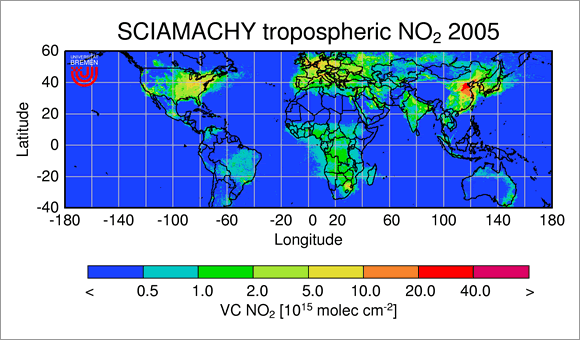The spectroscopic analysis of the composition of the Earth's atmosphere using ground-based spectrometers and using the Sun as a radiation source has been going on for more than a century. The Sun is not an ideal source of light for such measurements: among other problems, the spectrum of its light is already heavily imprinted with absorption structures — the Fraunhofer lines — from species in the atmosphere of the Sun itself.
The strength of these absorptions meant that for a long time it was difficult to detect weak absorbers in the Earth's atmosphere. The first measurements of atmospheric absorbers were mainly restricted to the effects of strong absorbers such as O3. In the 1970s the first measurements of NO2 were made from ground stations.
All ground station measurements suffered from the problem that the spectrum of the 'pure' solar irradiance — that is, sunlight before it had interacted with the Earth's atmosphere — was not available. The strong structures of the Fraunhofer lines could therefore only be cancelled out by, for example, taking one spectrum measured during sunset or sunrise, which, because of the long atmospheric light path contains much stronger absorption structures of the atmospheric absorber, and then dividing it by another spectrum measured at noon.
In contrast, satellite-based spectrometers can measure
- spectra from the direct passage of sunlight through the atmosphere,
- spectra from the 'earthshine', the sunlight arriving at the satellite from the Earth that has been scattered and reflected in the atmosphere and at the surface, and
- the spectrum of direct sunlight, which contains no atmospheric absorptions.
Therefore compared with ground-based measurements, which can only take the difference between various atmospheric spectra, the spectra from satellite-based measurements can be related to the 'pure' spectrum of the incident sunlight.

Fig 1.2.1: Worldwide tropospheric NO2 distribution as seen by the SCIAMACHY instrument on the ENVISAT satellite.
Image courtesy of :
Satellite-based measurements have a number of other important advantages over ground-based measurements:
- Satellite-based instruments can perform global observations of the atmosphere for tropospheric NO2, allowing long-term series of data to be collected.
- Remote-sensing measurements can often be automated so that several parameters can be determined simultaneously.
- Satellite-based instruments provide a comprehensive view of the world's environment on a scale not possible by other means, thus offering a full global mapping of the atmospheric composition.